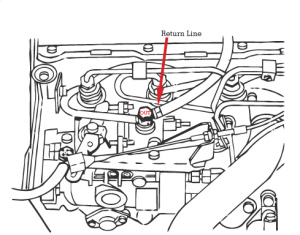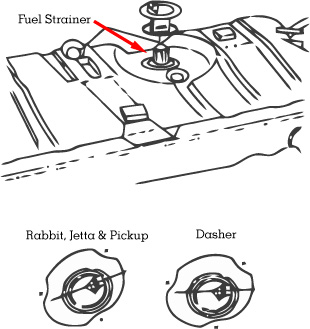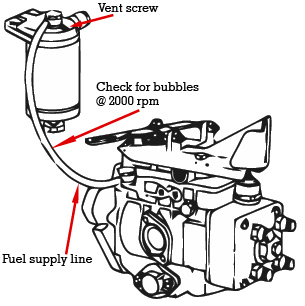- Start the engine and run it at about 2000 RPM.
- Check the clear fuel supply line. A steady stream of bubbles indicates either an air leak in the fuel suply system or water
in the fuel filter. (A few bubbles may appear, this is normal) - Check for air leaks caused by:
– Loose fuel filter
– Loose connections on fuel filter assembly
– Loose union bolt on fuel pump
– Loose connections on fuel supply lines Loose bleeder screw on filter housingIf no air leaks are found and if bubbles still appear, the bubbles could be water in the fuel. - Drain the water trap in the fuel filter.
– Open the vent screw on the filter flange. Loosen the drain plug on the filter.
– Drain the fuel into a container until the drained fuel is pure.
– Tighten the drain plug and the vent screw.
Check Union Bolts
 Check the union bolts on the injection pump to make sure the correct bolts are installed on the fuel supply and return lines.
Check the union bolts on the injection pump to make sure the correct bolts are installed on the fuel supply and return lines.
The bolt on the fuel return line should be marked out, and have a very small opening which is visible when the bolt is removed. The restrictor helps maintain fuel pressure inside the injection pump.
Remove fuel tank strainer
(Rabbit, Jetta, Dasher, and Pick-up only)
 In areas where the temperature drops below 20° F, the fuel tank strainer should be removed.
In areas where the temperature drops below 20° F, the fuel tank strainer should be removed.
- Remove the fuel gauge sending unit.
- Remove the fuel tank strainer.
- Replace the O ring for the sending unit and lubricate it with graphite powder.
- Install the fuel gauge sending unit (note the installation position).
If wax crystals are visible in the fuel tank, see ‘Overcoming Cold Weather Problems With Diesel Fuel’ at THIS LINK.
Verify fuel quality
Poor fuel quality can cause a cold running problem or a no start condition. The causes could be:
Fuel not winterized — At temperatures below 20°F, wax crystals begin to form in the fuel. This will plug the fuel lines, cutting off the fuel supply to the engine.
Improper mixing — If too much gasoline or other flow improvers are mixed with the fuel, the cetane rating of the fuel will be lowered below the point at which it will burn properly in the engine

